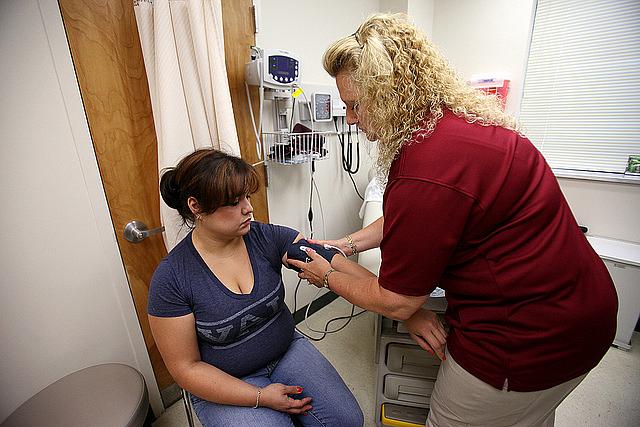How health reform will lead to more people diagnosed with chronic conditions

People with insurance are about 9 percent more likely to be diagnosed with high blood pressure.
The Affordable Care Act could significantly improve health for those with chronic diseases as increased diagnosis leads to treatment of their diabetes, high blood pressure and high cholesterol. But more policy attention is needed to address the growing demand for health care services and spending for these chronic conditions.
Those are the findings of a study published this month in Health Affairs, which analyzed data from the National Health and Nutrition Examination Study. The goal was to evaluate the relationship between health insurance and the diagnosis and management of diabetes, high cholesterol and high blood pressure.
“Our findings suggest that the ACA could have significant effects on the identification and management of chronic disease,” the authors wrote.
The study is noteworthy for examining the effects of the ACA on Americans’ health. Previously, the financial impact of insurance — such as decreases in medical-related bankruptcies — has been well documented. But the impact of the ACA on the health of Americans is still largely unclear, as is the law’s impact on future health care demands and spending.
If the number of nonelderly Americans without health insurance were reduced by half, researchers estimate there would be 1.5 million people with a diagnosis of one or more chronic conditions. And, there would be about 650,000 fewer people with uncontrolled cases. (In a hypothetical scenario in which all nonelderly Americans had health insurance, those predictions would soar to 3.1 million people with a diagnosis of one of these chronic conditions and 1.3 million fewer people with uncontrolled cases).
“From a health system perspective, these are positive outcomes that would have important implications for the health of the U.S. population,” the authors wrote.
People with insurance are significantly more likely to be diagnosed with a chronic condition than uninsured people — by about 14 percentage points for diabetes and high cholesterol and about 9 percentage points for high blood pressure. For patients with an existing diagnosis, having insurance was associated with lower hemoglobin A1c (a measure which reflects how well diabetes is controlled), lower total cholesterol, and lower blood pressure.
Those reductions represent moderate to large effects, although they are less than what standard drug therapy might provide, study author Joshua Salomon, a Harvard professor of global health, told Center for Health Journalism Digital. One possible reason could be quality of care differences. The main takeaway is that there is a strong positive effect on health when diagnoses increase, though the benefits are better if patients receive the best management of chronic diseases available, he said.
Their study isn’t the first to suggest health insurance can increase improve the diagnosis and control of diseases. But this latest report widens in scope to examine “potential population-level health impacts” of the ACA’s insurance expansion, and adds contemporary data.
Researchers also acknowledged the need to prepare the health system for the influx of the additional people who will be identified as having these chronic diseases. “These people will need regular access to health care providers, and policy makers need to rethink their strategy for ensuring that newly insured patients can get the care they need,” they wrote.
One way to improve the likelihood they find needed care is to allow mid-level providers such as nurse practitioners to fulfill some of the duties traditionally limited to doctors, the paper suggests.
Along with access to care, cost is another challenge policy makers will be forced to address. The cost of rising chronic disease diagnoses has been well documented among elderly Medicare beneficiaries, who are now living longer with higher rates of obesity and disability. USC Schaeffer’s Future Elderly Model (FEM), for example, predicts Medicare spending will more than double to $1.2 trillion by 2030, in part due to chronic conditions such as diabetes as well as the demographic boom represented by Baby Boomers.
The authors of the Health Affairs study also acknowledged that newly-diagnosed patients will likely drive up medical expenses, at least in the short term. But better management of chronic conditions could lead to reductions in health care spending as more significant complications from chronic diseases — and the costly medical interventions that often follow — can potentially be averted in the long run.
It’s naïve to hope that we will find a lot of medical interventions in general that are both cost saving and health improving, Salomon said. But he says that isn’t necessarily the standard society should be seeking.
“The fact of the matter is that health is valuable to us and so we are, as a society, willing to spend money for health,” he said. “The real focus we should have is: Are we spending money in a way that gets us the most health for what we’re willing to spend? Are we getting good value for our money? ... We have to believe that via diagnosis and providing people access to care, we’re producing outcomes that have value to us as a society.”
[Photo by Fort George G. Meade PAO via Flickr.]

